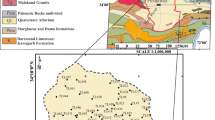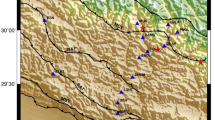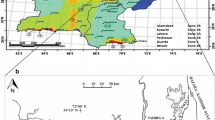Abstract
The importance of characterizing the site effects in urban areas, especially Mumbai, the commercial capital of India, with a quarter of land below sea level, is well realized. Mumbai is built on a cluster of seven basaltic islands that were merged together through reclamation of land from the Arabian Sea. Due to rapid urbanization, the demarcation between reclaimed areas and original islands is blurred. A pilot study is undertaken to investigate and characterize the local site effects at 27 locations in Mumbai. The Nakamura technique is used to estimate the fundamental frequency of soft soils at each site, characterized by the ratio (H/V) of the Fourier spectra of the horizontal and vertical components of ambient noise measurements made with a 3-component short period (1 Hz) seismograph. Validation of peak frequency was done using both pre-event and event data. The peak amplification was also validated through measurements at a 10-m exposed soil section and over a soil dump. Overall, the site responses correlate well with the local geology and the lithologs obtained at 40 boreholes at 8 locations The reclaimed areas are characterized by resonance frequencies ranging from 3.3 to 4.6 Hz with significant peak amplification (>4) in contrast to hard rock sites that do not exhibit peak amplification. The hard rock sites with soil cover exhibit peak amplification in the frequency range 3.3–10.5 Hz indicating large variations in soil thickness. The H/V curves at most sites exhibit clear single peaks with large amplitude, which could be associated with sharp discontinuities corresponding to a uni-model of a single layer with large velocity contrast overlying the basement. The low resonance frequencies together with large amplification of site responses enable identifying and demarcating reclaimed areas that form important inputs in the seismic microzonation of Mumbai.









Similar content being viewed by others
References
Bansal BK, Gupta S (1998) A glance through the seismicity of peninsular India. J Geol Soc India 52:67–80
Chandra U (1977) Earthquakes of peninsular India—a seismotectonic study. Bull Seismol Soc Am 67:1387–1413
Fah D, Ruttener E, Noack Th, Kruspan P (1997) Microzonation of the city of basel. Journal of Seismology 1:87–102
Field EH, Jacob K (1993) The theoretical response of sedimentary layers to ambient seismic noise. Geo Res Lett 24:2925–2928
Geological Survey of India (2001) District Resource Map, Mumbai District, Maharashtra
Ibs-von Seht M, Wohlenberg J (1999) Microtremor measurements used to map thickness of soft sediments. Bull Seis Soc Am 89(1):250–259
Kanth STGR, Iyengar RN (2006) Seismic hazard estimation for Mumbai city. Current Science 91:1486–1494
Lachet C, Bard PY (1994) Numerical and theoretical investigations on the possibilities and limitations of Nakamura’s technique. J Phy Earth 42:377–397
Lachet C, Hatzfeld D, Bard PY, Theodulidis N, Papaloannou C, Savvaidis A (1996) Site effects and microzonation in the city of Thessaloniki (Greece). Comparison of different approaches. Bull Seism Soc Am 86:1692–1703
Lermo J, Chavez-Garcia FJ (1994) Are microtremors useful in site response evaluations? Bull Seis Soc Am 84:1350–1364
Mohan G, Surve G, Tiwari P (2007) Seismic evidences of faulting beneath the Panvel flexure. Curr Sci 93(7):991–996
Nakamura Y (1989) A method for dynamic characteristics estimation of subsurface using microtremor on the ground surface. Q Rep Railway Tech Res Inst 30(1):25–33
Nogoshi M, Igarashi T (1971) On the amplitude characteristics of microtremor (Part 2). Jour Seism Soc Japan 24:26–40
Ohmachi T, Nakamura Y, Toshinawa T (1991) Ground motion characteristics in the San Francisco Bay area detected by microtremor measurments, In: Proceedings of 2nd international conference on recent advance. 11–15 March, St. Louis, Missouri, pp 1643–1648 (In Geot Earth Eng and Soil Dyn)
Parolai S, Bindi D, Baumbach M, Grosser H, Milkereit C, Karakisa S, Zunbul S (2004) Comparison of different site response estimation techniques using aftershocks of the 1999 Izmit earthquake. Bull Seis Soc Am 94:1096–1108
Rastogi BK, Chadha RK, Raju IP (1986) Seismicity near Bhatsa reservoir, Maharashtra, India. Phy Ear Plan Int 44:179–199
Ravi Kumar M, Bhatia SC (1999) A new seismic hazard map for the Indian plate region under the global seismic hazard assessment programme. Curr Sci 77:447–453
Sesame (2004) Site effects assessment using ambient excitations European research project. http://sesame-fp5.obs.ujf-grenoble.fr
Survey of India, Antique Maps (1990) Bombay through centuries, Published by Survey of India, Govt. of India
Acknowledgments
This work was sponsored by the state government of Maharashtra, India. The first author is thankful to the Director, Indian Institute of Geomagnetism, Navi Mumbai for encouragement.
Author information
Authors and Affiliations
Corresponding author
Rights and permissions
About this article
Cite this article
Surve, G., Mohan, G. Site response studies in Mumbai using (H/V) Nakamura technique. Nat Hazards 54, 783–795 (2010). https://doi.org/10.1007/s11069-010-9503-z
Received:
Accepted:
Published:
Issue Date:
DOI: https://doi.org/10.1007/s11069-010-9503-z




